The Curious Case of Benjamin Button - Lifespan Development
VerifiedAdded on 2023/06/10
|7
|2223
|122
AI Summary
This article explores the lifespan development of the protagonist in the film The Curious Case of Benjamin Button. It covers different stages of development and relates them to various theories proposed by psychologists.
Contribute Materials
Your contribution can guide someone’s learning journey. Share your
documents today.
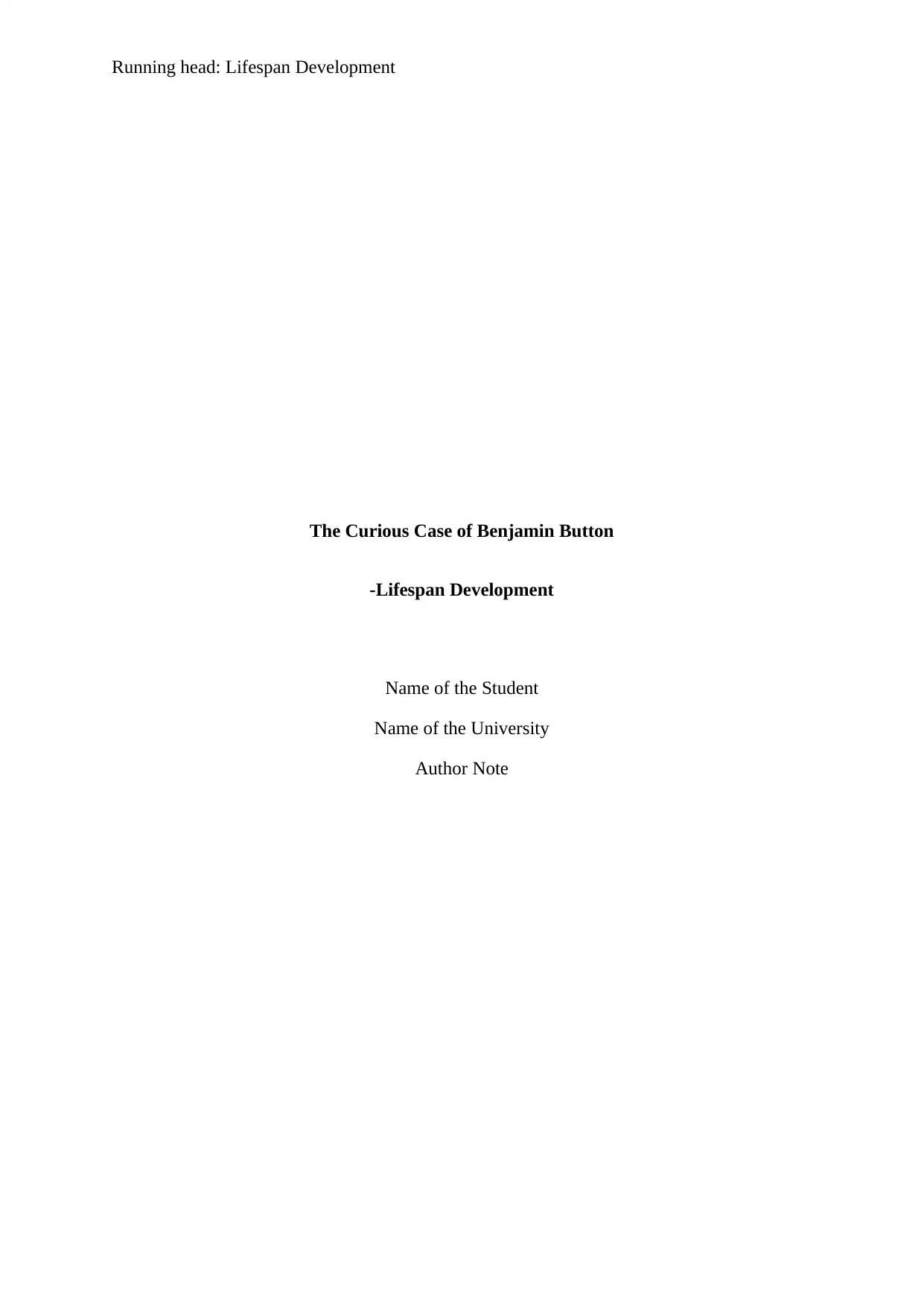
Running head: Lifespan Development
The Curious Case of Benjamin Button
-Lifespan Development
Name of the Student
Name of the University
Author Note
The Curious Case of Benjamin Button
-Lifespan Development
Name of the Student
Name of the University
Author Note
Secure Best Marks with AI Grader
Need help grading? Try our AI Grader for instant feedback on your assignments.
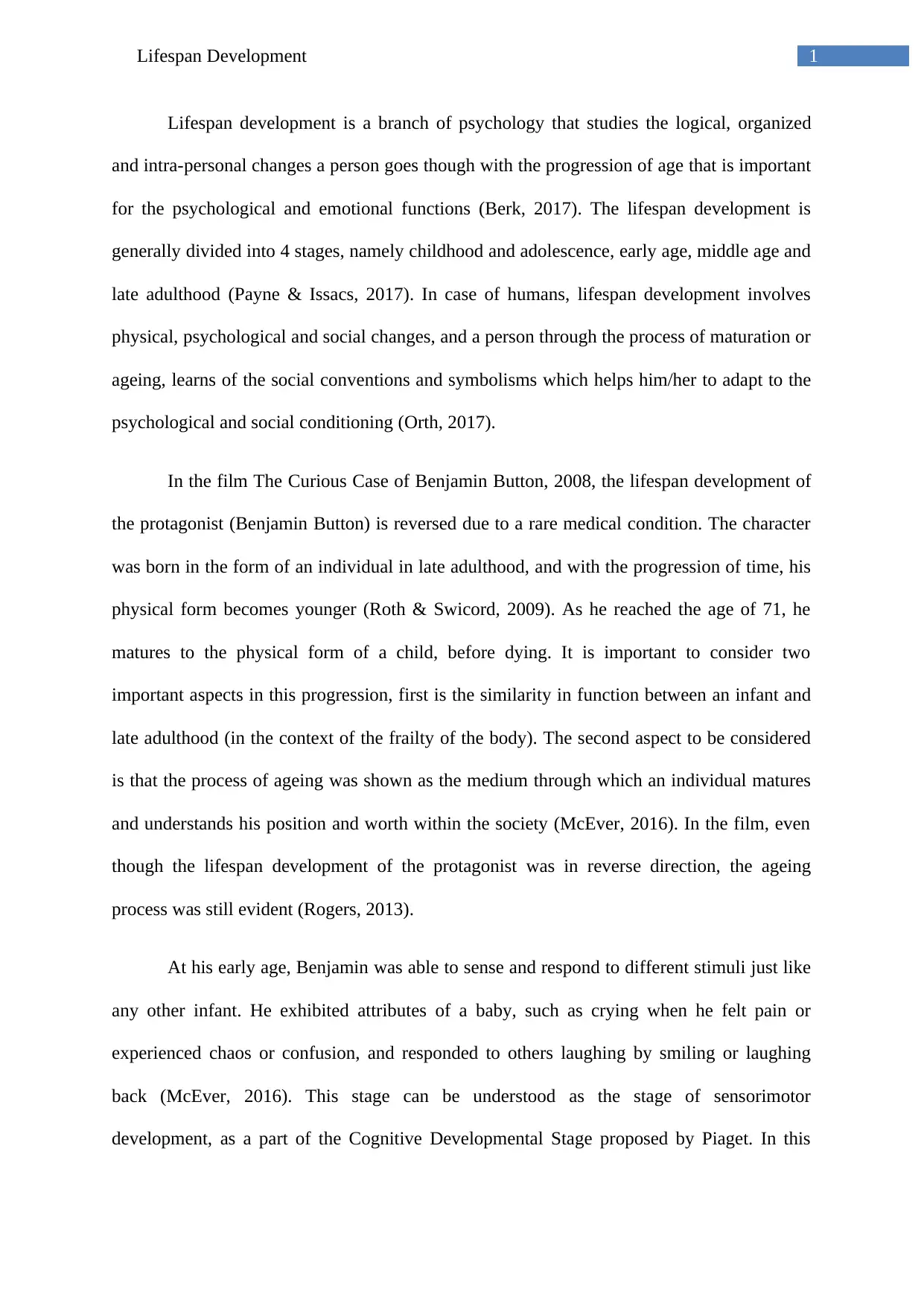
1Lifespan Development
Lifespan development is a branch of psychology that studies the logical, organized
and intra-personal changes a person goes though with the progression of age that is important
for the psychological and emotional functions (Berk, 2017). The lifespan development is
generally divided into 4 stages, namely childhood and adolescence, early age, middle age and
late adulthood (Payne & Issacs, 2017). In case of humans, lifespan development involves
physical, psychological and social changes, and a person through the process of maturation or
ageing, learns of the social conventions and symbolisms which helps him/her to adapt to the
psychological and social conditioning (Orth, 2017).
In the film The Curious Case of Benjamin Button, 2008, the lifespan development of
the protagonist (Benjamin Button) is reversed due to a rare medical condition. The character
was born in the form of an individual in late adulthood, and with the progression of time, his
physical form becomes younger (Roth & Swicord, 2009). As he reached the age of 71, he
matures to the physical form of a child, before dying. It is important to consider two
important aspects in this progression, first is the similarity in function between an infant and
late adulthood (in the context of the frailty of the body). The second aspect to be considered
is that the process of ageing was shown as the medium through which an individual matures
and understands his position and worth within the society (McEver, 2016). In the film, even
though the lifespan development of the protagonist was in reverse direction, the ageing
process was still evident (Rogers, 2013).
At his early age, Benjamin was able to sense and respond to different stimuli just like
any other infant. He exhibited attributes of a baby, such as crying when he felt pain or
experienced chaos or confusion, and responded to others laughing by smiling or laughing
back (McEver, 2016). This stage can be understood as the stage of sensorimotor
development, as a part of the Cognitive Developmental Stage proposed by Piaget. In this
Lifespan development is a branch of psychology that studies the logical, organized
and intra-personal changes a person goes though with the progression of age that is important
for the psychological and emotional functions (Berk, 2017). The lifespan development is
generally divided into 4 stages, namely childhood and adolescence, early age, middle age and
late adulthood (Payne & Issacs, 2017). In case of humans, lifespan development involves
physical, psychological and social changes, and a person through the process of maturation or
ageing, learns of the social conventions and symbolisms which helps him/her to adapt to the
psychological and social conditioning (Orth, 2017).
In the film The Curious Case of Benjamin Button, 2008, the lifespan development of
the protagonist (Benjamin Button) is reversed due to a rare medical condition. The character
was born in the form of an individual in late adulthood, and with the progression of time, his
physical form becomes younger (Roth & Swicord, 2009). As he reached the age of 71, he
matures to the physical form of a child, before dying. It is important to consider two
important aspects in this progression, first is the similarity in function between an infant and
late adulthood (in the context of the frailty of the body). The second aspect to be considered
is that the process of ageing was shown as the medium through which an individual matures
and understands his position and worth within the society (McEver, 2016). In the film, even
though the lifespan development of the protagonist was in reverse direction, the ageing
process was still evident (Rogers, 2013).
At his early age, Benjamin was able to sense and respond to different stimuli just like
any other infant. He exhibited attributes of a baby, such as crying when he felt pain or
experienced chaos or confusion, and responded to others laughing by smiling or laughing
back (McEver, 2016). This stage can be understood as the stage of sensorimotor
development, as a part of the Cognitive Developmental Stage proposed by Piaget. In this

2Lifespan Development
stage a baby is able to perceive the environment through the auditory, olfactory and tactile
stimuli, which is what the protagonist was able to do in his early life (Saxe, 2015).
Growing into a child, the protagonist was able to learn how to behave and read, and
exhibit Representational Thinking and Object Permanence (Smith, 2017; Bremner et al.,
2015). When the protagonist was banging the table with a fork, it represented assimilation of
knowledge, since he never saw that action being done before, but he assimilated that
knowledge by banging the table with other objects, a schema that he used to understand that
forks can be used in a similar way, which was later rectified by Queenie, who helped him
understand that fork was for eating food, and not to bang the table. The protagonist was
shown to have grown fond and attached to Queenie, who used to take care of him since he
was abandoned by his father (McEver, 2016). This can be compared to the Theory of
Attachment proposed by Mary Ainworth (Grossman et al., 2016). However, Benjamin did not
mind being alone at time in the house, which showed the hallmark traits of an avoidant kid
(McEver, 2016). When Benjamin started to learn how to read and pronounce words properly
with the help of Tizzy, the process could be related to the Zone of Proximal Development
proposed by Vygotsky, as it showed the protagonist learning with the help of the adult
supervision or guidance and was soon able to read on his own (Eun, 2017). He also exhibited
object permanence, and representational thought by being able to find his way back home,
when he was abandoned in the city by Oti. At that age, the protagonist also lacked the
understanding of the gender differences (like any other child at the same developmental
stage), as well as being egocentric, which prevented him to understand the point of view of
others (Rochat, 2017; McEver, 2016).
His understanding of the gender difference and gender roles developed when
Benjamin became a teenager, and he started to show signs of autonomy. He started to grow
his hair and felt stronger with development of muscles. When he started working on a tugboat
stage a baby is able to perceive the environment through the auditory, olfactory and tactile
stimuli, which is what the protagonist was able to do in his early life (Saxe, 2015).
Growing into a child, the protagonist was able to learn how to behave and read, and
exhibit Representational Thinking and Object Permanence (Smith, 2017; Bremner et al.,
2015). When the protagonist was banging the table with a fork, it represented assimilation of
knowledge, since he never saw that action being done before, but he assimilated that
knowledge by banging the table with other objects, a schema that he used to understand that
forks can be used in a similar way, which was later rectified by Queenie, who helped him
understand that fork was for eating food, and not to bang the table. The protagonist was
shown to have grown fond and attached to Queenie, who used to take care of him since he
was abandoned by his father (McEver, 2016). This can be compared to the Theory of
Attachment proposed by Mary Ainworth (Grossman et al., 2016). However, Benjamin did not
mind being alone at time in the house, which showed the hallmark traits of an avoidant kid
(McEver, 2016). When Benjamin started to learn how to read and pronounce words properly
with the help of Tizzy, the process could be related to the Zone of Proximal Development
proposed by Vygotsky, as it showed the protagonist learning with the help of the adult
supervision or guidance and was soon able to read on his own (Eun, 2017). He also exhibited
object permanence, and representational thought by being able to find his way back home,
when he was abandoned in the city by Oti. At that age, the protagonist also lacked the
understanding of the gender differences (like any other child at the same developmental
stage), as well as being egocentric, which prevented him to understand the point of view of
others (Rochat, 2017; McEver, 2016).
His understanding of the gender difference and gender roles developed when
Benjamin became a teenager, and he started to show signs of autonomy. He started to grow
his hair and felt stronger with development of muscles. When he started working on a tugboat
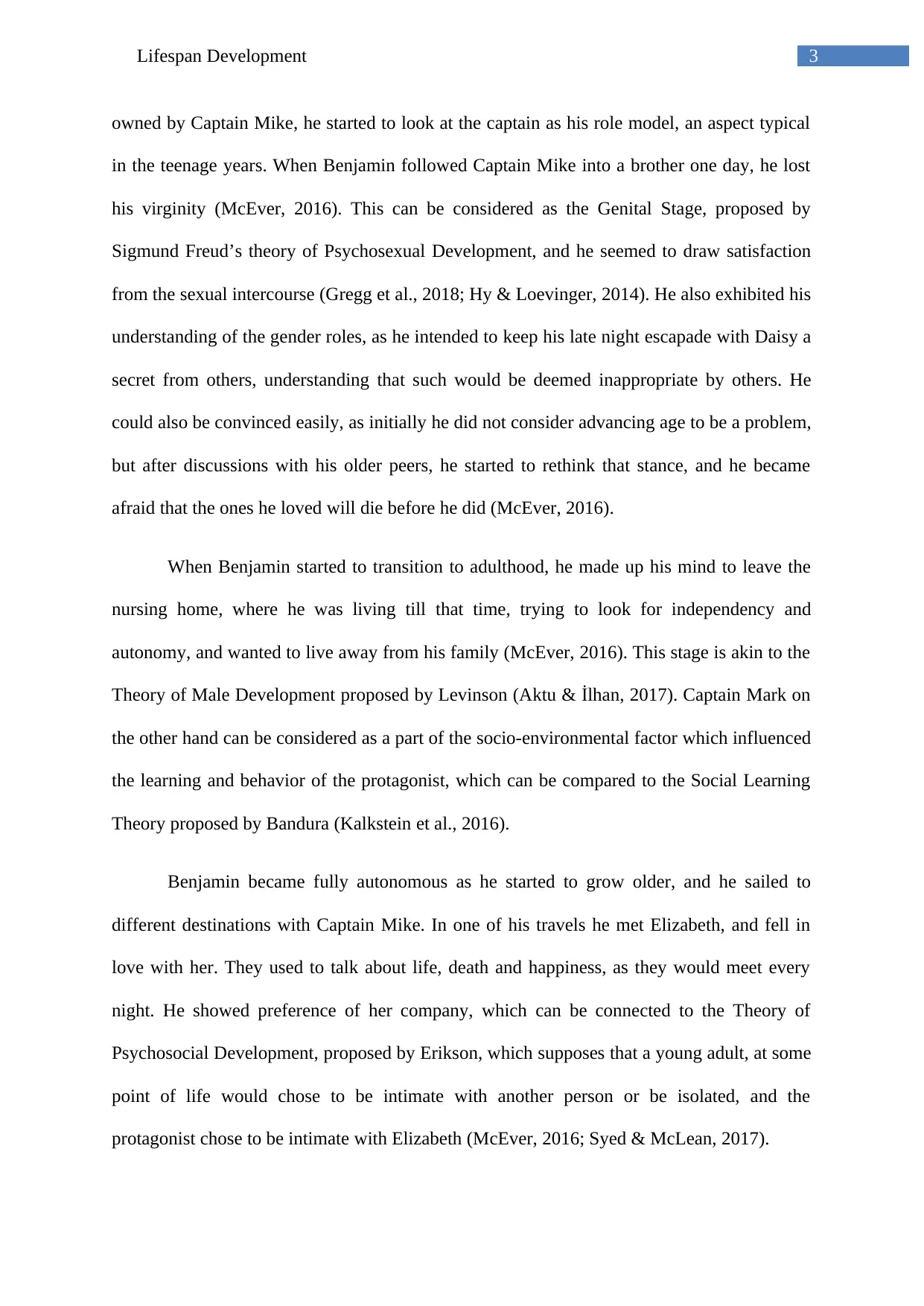
3Lifespan Development
owned by Captain Mike, he started to look at the captain as his role model, an aspect typical
in the teenage years. When Benjamin followed Captain Mike into a brother one day, he lost
his virginity (McEver, 2016). This can be considered as the Genital Stage, proposed by
Sigmund Freud’s theory of Psychosexual Development, and he seemed to draw satisfaction
from the sexual intercourse (Gregg et al., 2018; Hy & Loevinger, 2014). He also exhibited his
understanding of the gender roles, as he intended to keep his late night escapade with Daisy a
secret from others, understanding that such would be deemed inappropriate by others. He
could also be convinced easily, as initially he did not consider advancing age to be a problem,
but after discussions with his older peers, he started to rethink that stance, and he became
afraid that the ones he loved will die before he did (McEver, 2016).
When Benjamin started to transition to adulthood, he made up his mind to leave the
nursing home, where he was living till that time, trying to look for independency and
autonomy, and wanted to live away from his family (McEver, 2016). This stage is akin to the
Theory of Male Development proposed by Levinson (Aktu & İlhan, 2017). Captain Mark on
the other hand can be considered as a part of the socio-environmental factor which influenced
the learning and behavior of the protagonist, which can be compared to the Social Learning
Theory proposed by Bandura (Kalkstein et al., 2016).
Benjamin became fully autonomous as he started to grow older, and he sailed to
different destinations with Captain Mike. In one of his travels he met Elizabeth, and fell in
love with her. They used to talk about life, death and happiness, as they would meet every
night. He showed preference of her company, which can be connected to the Theory of
Psychosocial Development, proposed by Erikson, which supposes that a young adult, at some
point of life would chose to be intimate with another person or be isolated, and the
protagonist chose to be intimate with Elizabeth (McEver, 2016; Syed & McLean, 2017).
owned by Captain Mike, he started to look at the captain as his role model, an aspect typical
in the teenage years. When Benjamin followed Captain Mike into a brother one day, he lost
his virginity (McEver, 2016). This can be considered as the Genital Stage, proposed by
Sigmund Freud’s theory of Psychosexual Development, and he seemed to draw satisfaction
from the sexual intercourse (Gregg et al., 2018; Hy & Loevinger, 2014). He also exhibited his
understanding of the gender roles, as he intended to keep his late night escapade with Daisy a
secret from others, understanding that such would be deemed inappropriate by others. He
could also be convinced easily, as initially he did not consider advancing age to be a problem,
but after discussions with his older peers, he started to rethink that stance, and he became
afraid that the ones he loved will die before he did (McEver, 2016).
When Benjamin started to transition to adulthood, he made up his mind to leave the
nursing home, where he was living till that time, trying to look for independency and
autonomy, and wanted to live away from his family (McEver, 2016). This stage is akin to the
Theory of Male Development proposed by Levinson (Aktu & İlhan, 2017). Captain Mark on
the other hand can be considered as a part of the socio-environmental factor which influenced
the learning and behavior of the protagonist, which can be compared to the Social Learning
Theory proposed by Bandura (Kalkstein et al., 2016).
Benjamin became fully autonomous as he started to grow older, and he sailed to
different destinations with Captain Mike. In one of his travels he met Elizabeth, and fell in
love with her. They used to talk about life, death and happiness, as they would meet every
night. He showed preference of her company, which can be connected to the Theory of
Psychosocial Development, proposed by Erikson, which supposes that a young adult, at some
point of life would chose to be intimate with another person or be isolated, and the
protagonist chose to be intimate with Elizabeth (McEver, 2016; Syed & McLean, 2017).
Secure Best Marks with AI Grader
Need help grading? Try our AI Grader for instant feedback on your assignments.
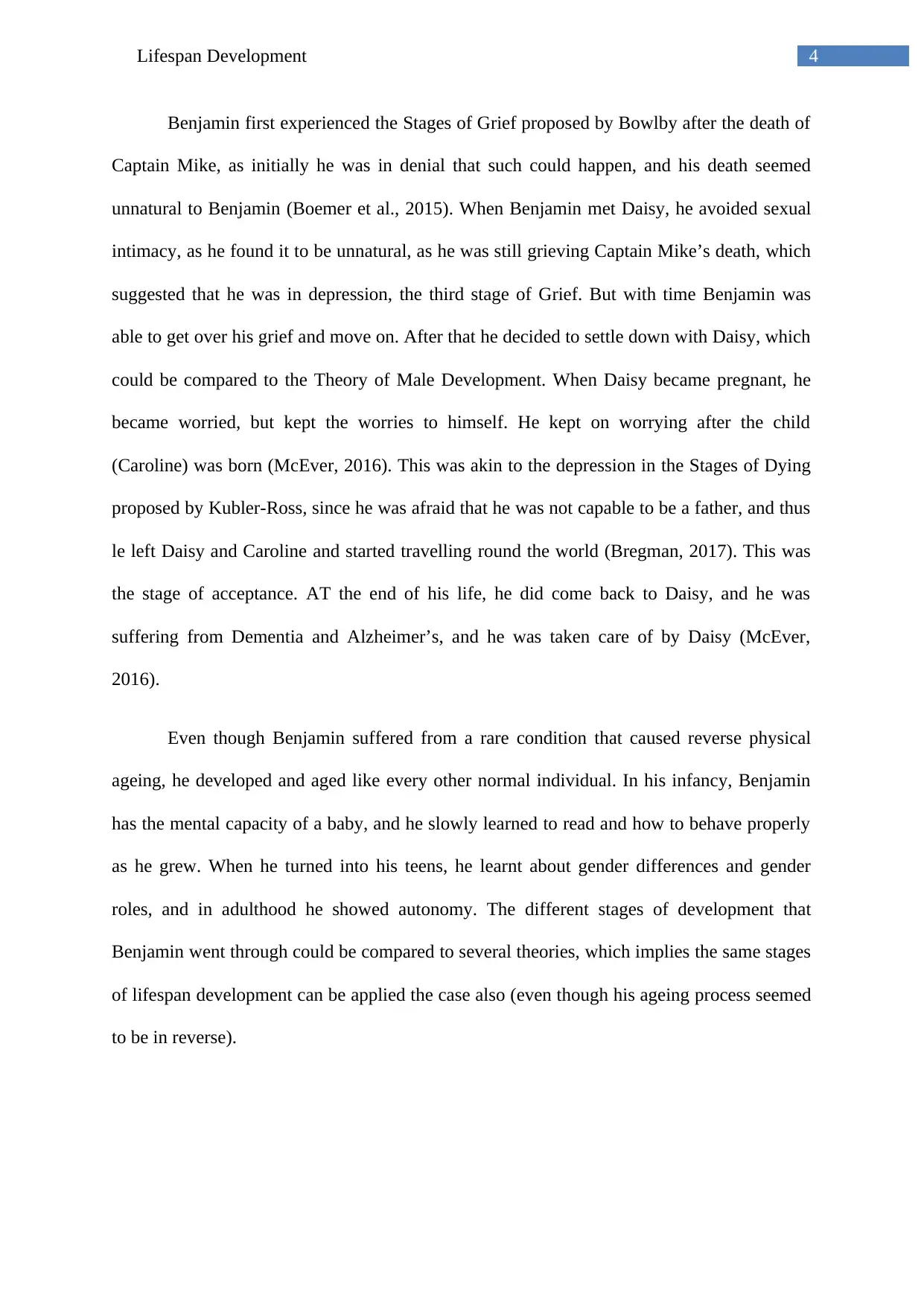
4Lifespan Development
Benjamin first experienced the Stages of Grief proposed by Bowlby after the death of
Captain Mike, as initially he was in denial that such could happen, and his death seemed
unnatural to Benjamin (Boemer et al., 2015). When Benjamin met Daisy, he avoided sexual
intimacy, as he found it to be unnatural, as he was still grieving Captain Mike’s death, which
suggested that he was in depression, the third stage of Grief. But with time Benjamin was
able to get over his grief and move on. After that he decided to settle down with Daisy, which
could be compared to the Theory of Male Development. When Daisy became pregnant, he
became worried, but kept the worries to himself. He kept on worrying after the child
(Caroline) was born (McEver, 2016). This was akin to the depression in the Stages of Dying
proposed by Kubler-Ross, since he was afraid that he was not capable to be a father, and thus
le left Daisy and Caroline and started travelling round the world (Bregman, 2017). This was
the stage of acceptance. AT the end of his life, he did come back to Daisy, and he was
suffering from Dementia and Alzheimer’s, and he was taken care of by Daisy (McEver,
2016).
Even though Benjamin suffered from a rare condition that caused reverse physical
ageing, he developed and aged like every other normal individual. In his infancy, Benjamin
has the mental capacity of a baby, and he slowly learned to read and how to behave properly
as he grew. When he turned into his teens, he learnt about gender differences and gender
roles, and in adulthood he showed autonomy. The different stages of development that
Benjamin went through could be compared to several theories, which implies the same stages
of lifespan development can be applied the case also (even though his ageing process seemed
to be in reverse).
Benjamin first experienced the Stages of Grief proposed by Bowlby after the death of
Captain Mike, as initially he was in denial that such could happen, and his death seemed
unnatural to Benjamin (Boemer et al., 2015). When Benjamin met Daisy, he avoided sexual
intimacy, as he found it to be unnatural, as he was still grieving Captain Mike’s death, which
suggested that he was in depression, the third stage of Grief. But with time Benjamin was
able to get over his grief and move on. After that he decided to settle down with Daisy, which
could be compared to the Theory of Male Development. When Daisy became pregnant, he
became worried, but kept the worries to himself. He kept on worrying after the child
(Caroline) was born (McEver, 2016). This was akin to the depression in the Stages of Dying
proposed by Kubler-Ross, since he was afraid that he was not capable to be a father, and thus
le left Daisy and Caroline and started travelling round the world (Bregman, 2017). This was
the stage of acceptance. AT the end of his life, he did come back to Daisy, and he was
suffering from Dementia and Alzheimer’s, and he was taken care of by Daisy (McEver,
2016).
Even though Benjamin suffered from a rare condition that caused reverse physical
ageing, he developed and aged like every other normal individual. In his infancy, Benjamin
has the mental capacity of a baby, and he slowly learned to read and how to behave properly
as he grew. When he turned into his teens, he learnt about gender differences and gender
roles, and in adulthood he showed autonomy. The different stages of development that
Benjamin went through could be compared to several theories, which implies the same stages
of lifespan development can be applied the case also (even though his ageing process seemed
to be in reverse).
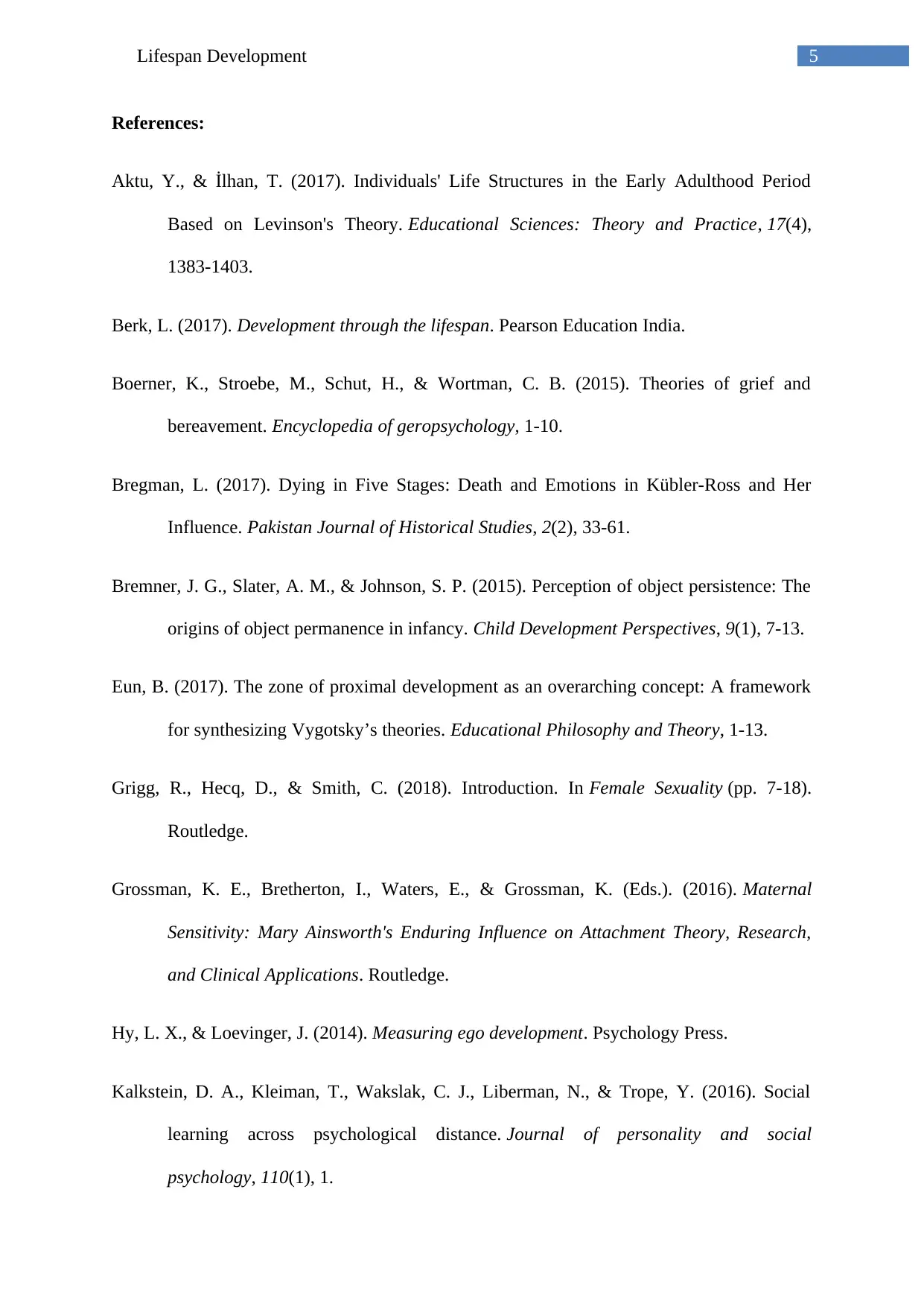
5Lifespan Development
References:
Aktu, Y., & İlhan, T. (2017). Individuals' Life Structures in the Early Adulthood Period
Based on Levinson's Theory. Educational Sciences: Theory and Practice, 17(4),
1383-1403.
Berk, L. (2017). Development through the lifespan. Pearson Education India.
Boerner, K., Stroebe, M., Schut, H., & Wortman, C. B. (2015). Theories of grief and
bereavement. Encyclopedia of geropsychology, 1-10.
Bregman, L. (2017). Dying in Five Stages: Death and Emotions in Kübler-Ross and Her
Influence. Pakistan Journal of Historical Studies, 2(2), 33-61.
Bremner, J. G., Slater, A. M., & Johnson, S. P. (2015). Perception of object persistence: The
origins of object permanence in infancy. Child Development Perspectives, 9(1), 7-13.
Eun, B. (2017). The zone of proximal development as an overarching concept: A framework
for synthesizing Vygotsky’s theories. Educational Philosophy and Theory, 1-13.
Grigg, R., Hecq, D., & Smith, C. (2018). Introduction. In Female Sexuality (pp. 7-18).
Routledge.
Grossman, K. E., Bretherton, I., Waters, E., & Grossman, K. (Eds.). (2016). Maternal
Sensitivity: Mary Ainsworth's Enduring Influence on Attachment Theory, Research,
and Clinical Applications. Routledge.
Hy, L. X., & Loevinger, J. (2014). Measuring ego development. Psychology Press.
Kalkstein, D. A., Kleiman, T., Wakslak, C. J., Liberman, N., & Trope, Y. (2016). Social
learning across psychological distance. Journal of personality and social
psychology, 110(1), 1.
References:
Aktu, Y., & İlhan, T. (2017). Individuals' Life Structures in the Early Adulthood Period
Based on Levinson's Theory. Educational Sciences: Theory and Practice, 17(4),
1383-1403.
Berk, L. (2017). Development through the lifespan. Pearson Education India.
Boerner, K., Stroebe, M., Schut, H., & Wortman, C. B. (2015). Theories of grief and
bereavement. Encyclopedia of geropsychology, 1-10.
Bregman, L. (2017). Dying in Five Stages: Death and Emotions in Kübler-Ross and Her
Influence. Pakistan Journal of Historical Studies, 2(2), 33-61.
Bremner, J. G., Slater, A. M., & Johnson, S. P. (2015). Perception of object persistence: The
origins of object permanence in infancy. Child Development Perspectives, 9(1), 7-13.
Eun, B. (2017). The zone of proximal development as an overarching concept: A framework
for synthesizing Vygotsky’s theories. Educational Philosophy and Theory, 1-13.
Grigg, R., Hecq, D., & Smith, C. (2018). Introduction. In Female Sexuality (pp. 7-18).
Routledge.
Grossman, K. E., Bretherton, I., Waters, E., & Grossman, K. (Eds.). (2016). Maternal
Sensitivity: Mary Ainsworth's Enduring Influence on Attachment Theory, Research,
and Clinical Applications. Routledge.
Hy, L. X., & Loevinger, J. (2014). Measuring ego development. Psychology Press.
Kalkstein, D. A., Kleiman, T., Wakslak, C. J., Liberman, N., & Trope, Y. (2016). Social
learning across psychological distance. Journal of personality and social
psychology, 110(1), 1.
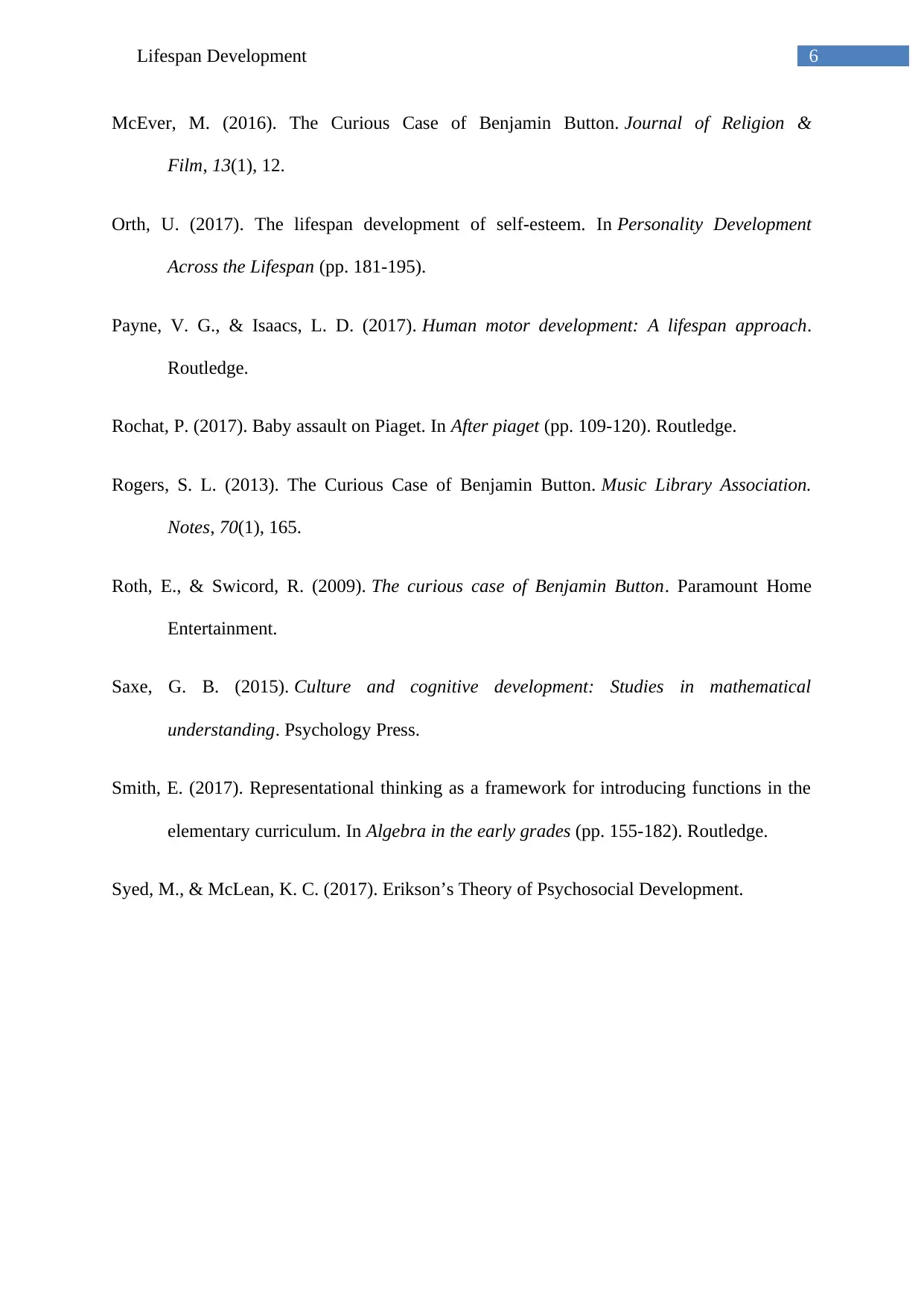
6Lifespan Development
McEver, M. (2016). The Curious Case of Benjamin Button. Journal of Religion &
Film, 13(1), 12.
Orth, U. (2017). The lifespan development of self-esteem. In Personality Development
Across the Lifespan (pp. 181-195).
Payne, V. G., & Isaacs, L. D. (2017). Human motor development: A lifespan approach.
Routledge.
Rochat, P. (2017). Baby assault on Piaget. In After piaget (pp. 109-120). Routledge.
Rogers, S. L. (2013). The Curious Case of Benjamin Button. Music Library Association.
Notes, 70(1), 165.
Roth, E., & Swicord, R. (2009). The curious case of Benjamin Button. Paramount Home
Entertainment.
Saxe, G. B. (2015). Culture and cognitive development: Studies in mathematical
understanding. Psychology Press.
Smith, E. (2017). Representational thinking as a framework for introducing functions in the
elementary curriculum. In Algebra in the early grades (pp. 155-182). Routledge.
Syed, M., & McLean, K. C. (2017). Erikson’s Theory of Psychosocial Development.
McEver, M. (2016). The Curious Case of Benjamin Button. Journal of Religion &
Film, 13(1), 12.
Orth, U. (2017). The lifespan development of self-esteem. In Personality Development
Across the Lifespan (pp. 181-195).
Payne, V. G., & Isaacs, L. D. (2017). Human motor development: A lifespan approach.
Routledge.
Rochat, P. (2017). Baby assault on Piaget. In After piaget (pp. 109-120). Routledge.
Rogers, S. L. (2013). The Curious Case of Benjamin Button. Music Library Association.
Notes, 70(1), 165.
Roth, E., & Swicord, R. (2009). The curious case of Benjamin Button. Paramount Home
Entertainment.
Saxe, G. B. (2015). Culture and cognitive development: Studies in mathematical
understanding. Psychology Press.
Smith, E. (2017). Representational thinking as a framework for introducing functions in the
elementary curriculum. In Algebra in the early grades (pp. 155-182). Routledge.
Syed, M., & McLean, K. C. (2017). Erikson’s Theory of Psychosocial Development.
1 out of 7
Your All-in-One AI-Powered Toolkit for Academic Success.
+13062052269
info@desklib.com
Available 24*7 on WhatsApp / Email
![[object Object]](/_next/static/media/star-bottom.7253800d.svg)
Unlock your academic potential
© 2024 | Zucol Services PVT LTD | All rights reserved.

